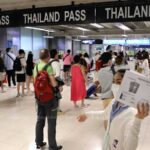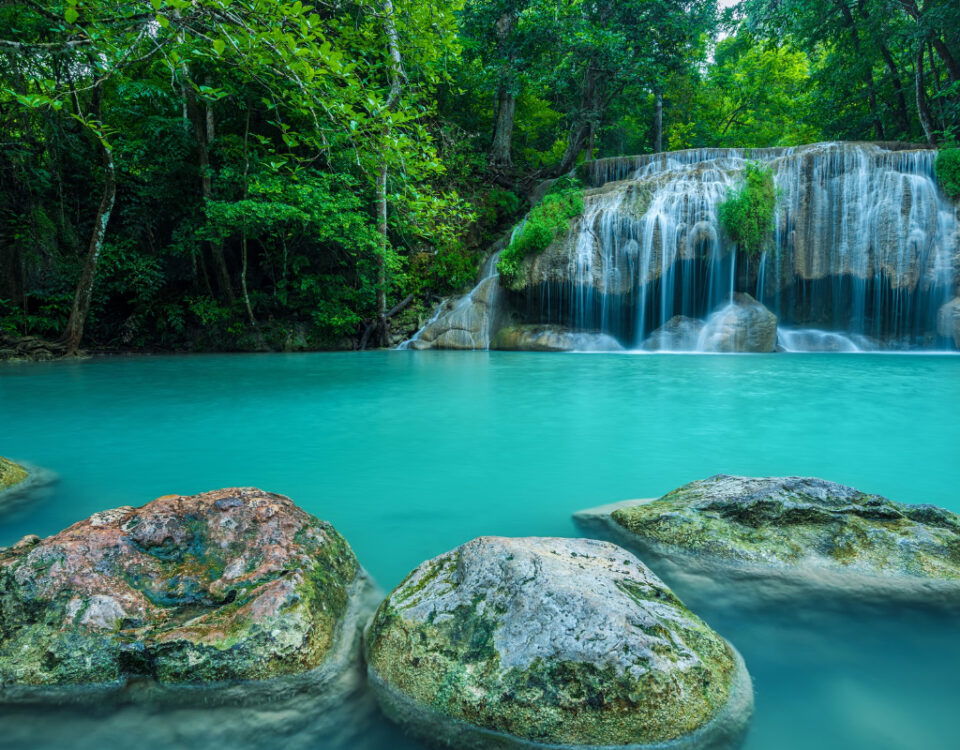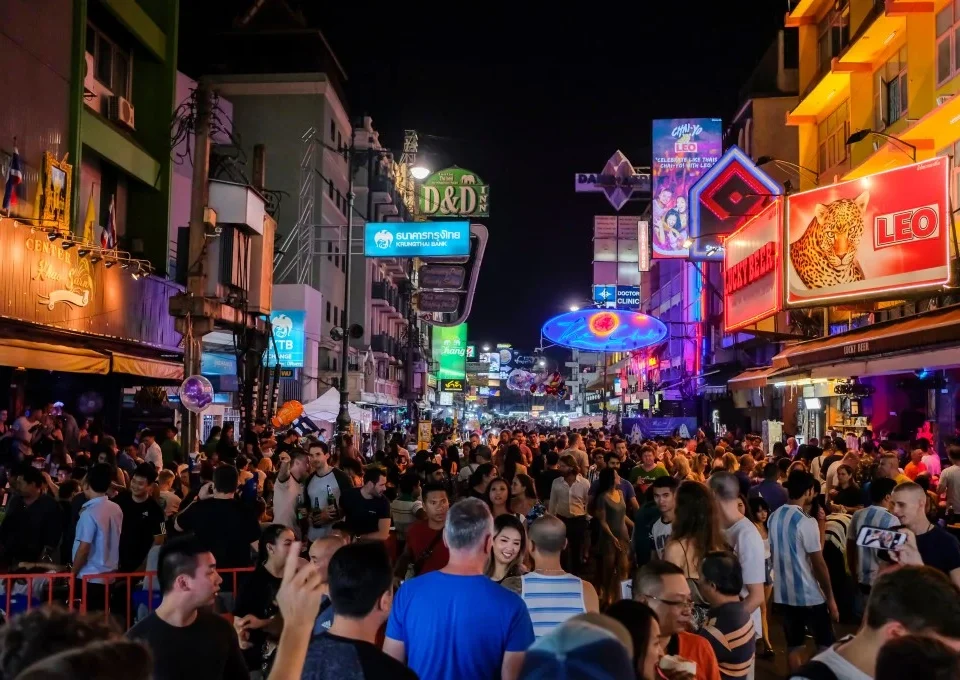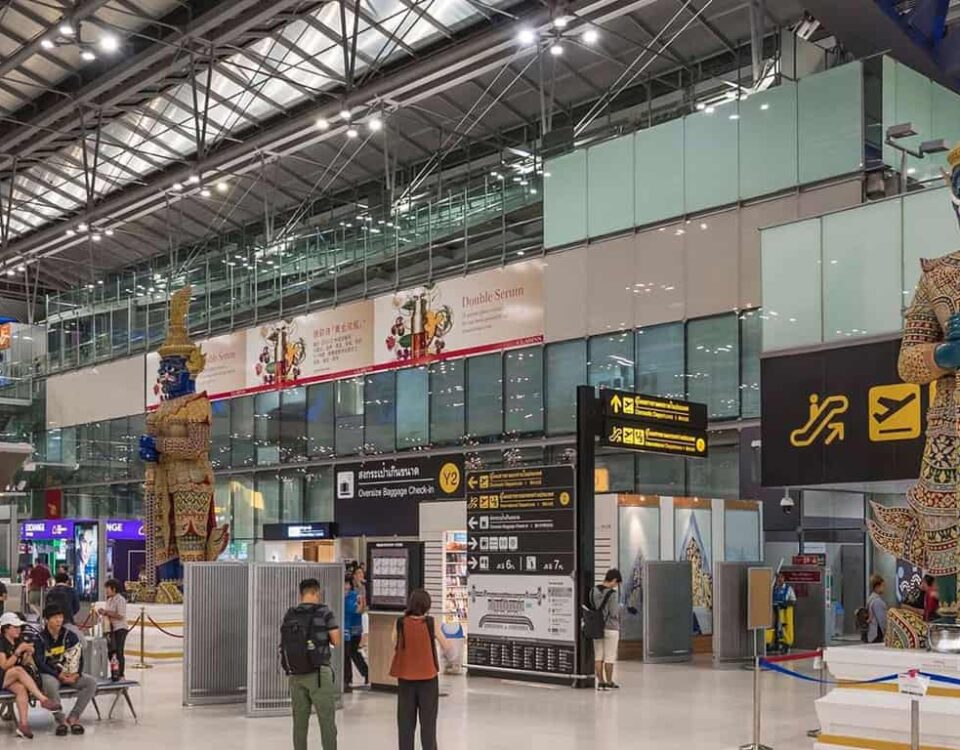
I Forgot to Fill TDAC: What to Do at Immigration
18/04/2025
TDAC Form – Explained, All You Need to Know Before Submitting
22/04/2025Thailand’s tropical climate makes it a year-round destination, but the weather varies significantly by month and region, influencing where and when to travel. From lush rainforests to pristine beaches, understanding Thailand’s weather patterns—rain, heat, and pollution—helps you plan the perfect trip. This 2,000+ word guide breaks down the climate month by month, recommends the best regions to visit, and highlights areas to avoid due to rain or pollution. Whether you’re dreaming of Bangkok’s vibrant streets, Chiang Mai’s temples, or Phuket’s beaches, we’ve got you covered with SEO-optimized insights for your 2025 Thailand adventure.
Thailand’s Climate Overview
Thailand has a tropical monsoon climate with three main seasons:
- Cool Season (November–February): Dry, pleasant temperatures (19–31°C), ideal for most regions.
- Hot Season (March–May): High temperatures (32–38°C), low rainfall, but pollution spikes in the north.
- Rainy Season (June–October): Heavy showers, especially in September–October, though some areas remain viable.
Rainfall and pollution (e.g., from crop burning) vary by region—north (Chiang Mai), central (Bangkok), west coast (Phuket), and east coast (Koh Samui). Below, we detail each month’s weather and recommend the best destinations while flagging areas impacted by rain or pollution.
January: Cool and Dry Bliss
Weather: January is peak cool season, with temperatures averaging 19–31°C. Expect clear skies, low humidity, and minimal rain across most of Thailand. Northern areas like Chiang Mai can dip to 15°C at night, while Bangkok and southern beaches stay warm (25–30°C).
Best Places to Visit:
- Chiang Mai & Chiang Rai (North): Perfect for temple tours, trekking, and festivals like the Chiang Mai Flower Festival. Cool evenings and clean air make outdoor activities delightful.
- Bangkok (Central): Ideal for sightseeing at the Grand Palace and Wat Arun, with comfortable temperatures for city exploration.
- Phuket, Krabi, Koh Phi Phi (West Coast): Sunny beaches and calm Andaman Sea waters, great for snorkeling and diving.
- Koh Samui, Koh Phangan (East Coast): Mostly dry, though occasional showers are possible. Good for beach holidays and Full Moon Parties.
Areas to Avoid:
- None. January’s weather is excellent nationwide, with negligible pollution.
Travel Tip: Book early—January is peak season, with higher crowds and prices. Pack a light jacket for northern evenings.
February: Sunny and Comfortable
Weather: Similar to January, February offers dry, sunny days (20–32°C) and low humidity. It’s one of the driest months, but northern air quality may start to decline due to early crop burning.
Best Places to Visit:
- Chiang Mai (North): Still great for cultural tours and night markets, though check air quality (AQI) via apps like AirVisual, as pollution can creep in late February.
- Bangkok & Ayutthaya (Central): Warm and dry, perfect for exploring temples and historical sites without the sticky heat.
- Phuket, Koh Lanta (West Coast): Crystal-clear waters and sunny skies, ideal for beach vacations and island-hopping.
- Koh Samui, Koh Tao (East Coast): Dry and sunny, excellent for diving and beach relaxation.
Areas to Avoid:
- Northern Highlands (e.g., Mae Hong Son): Early pollution from crop burning may reduce visibility and air quality, especially late in the month.
Travel Tip: February’s great for outdoor festivals like Chinese New Year. Wear sunscreen—UV levels are high even in cooler weather.
March: Hot but Mostly Dry
Weather: March marks the start of the hot season, with temperatures climbing to 32–36°C. Humidity rises, and rainfall remains low, but northern pollution peaks due to widespread crop burning (PM2.5 levels can exceed safe limits).
Best Places to Visit:
- Bangkok (Central): Hot but dry, suitable for indoor attractions like museums or shopping at Siam Paragon.
- Phuket, Krabi (West Coast): Sunny and warm, perfect for beach holidays before the rainy season begins.
- Koh Samui, Koh Phangan (East Coast): Minimal rain, great for scuba diving and beach parties.
- Hua Hin, Pattaya (Central Coast): Dry and less crowded than southern islands, good for golf or family-friendly resorts.
Areas to Avoid:
- Chiang Mai, Chiang Rai (North): Severe air pollution from crop burning makes March risky for those with respiratory issues. Wear an N95 mask if visiting, and limit outdoor activities.
Travel Tip: Monitor AQI daily in the north. Pack lightweight, breathable clothing and stay hydrated.
April: Swelteringly Hot
Weather: April is Thailand’s hottest month, with temperatures hitting 35–40°C and high humidity. Rainfall increases slightly, especially late in the month. Northern pollution lingers early but improves after mid-April rains.
Best Places to Visit:
- Koh Samui, Koh Tao (East Coast): Hot but mostly dry, ideal for beach escapes and diving.
- Phuket, Koh Phi Phi (West Coast): Still sunny early in April, though showers may start by month’s end. Great for Songkran (Thai New Year, mid-April) celebrations.
- Bangkok (Central): Hot but manageable for indoor activities or Songkran water fights, a cultural highlight.
- Kanchanaburi (Central): Dry enough for visiting waterfalls and historical sites like the Death Railway.
Areas to Avoid:
- Chiang Mai, Northern Highlands (North): Pollution remains high early in April, and intense heat makes trekking uncomfortable.
Travel Tip: Join Songkran festivities but expect crowds. Apply high-SPF sunscreen and carry a reusable water bottle.
May: Rainy Season Begins
Weather: May ushers in the rainy season, with temperatures dropping slightly (30–35°C) but humidity soaring. Short, heavy showers occur, especially in the north and west coast, though sunny intervals persist.
Best Places to Visit:
- Koh Samui, Koh Phangan (East Coast): Less rain than the west, making it a solid choice for beach holidays.
- Bangkok (Central): Rainy but manageable—focus on indoor attractions like Chatuchak Market or MBK Center.
- Hua Hin (Central Coast): Drier than the west coast, good for relaxed getaways.
- Khao Sok National Park (South): Lush and green during early rains, ideal for nature lovers despite occasional showers.
Areas to Avoid:
- Phuket, Krabi, Koh Lanta (West Coast): Heavy rain and rough seas begin, disrupting ferry services and beach activities.
- Chiang Mai (North): Frequent showers and lingering heat reduce outdoor appeal.
Travel Tip: Pack a lightweight raincoat and non-slip shoes. May’s shoulder season offers lower hotel prices.
June: Wet but Lush
Weather: June brings regular rain (4–8 inches), often in afternoon downpours, with temperatures around 29–33°C. Humidity is high, but northern landscapes turn vibrant green.
Best Places to Visit:
- Koh Samui, Koh Tao (East Coast): Drier than the west, with sunny mornings perfect for beaches and diving.
- Bangkok (Central): Rainy but vibrant—visit temples early or enjoy rooftop bars during clear evenings.
- Chiang Mai (North): Lush scenery suits rice paddy tours or indoor cultural sites like museums, though expect daily showers.
- Khao Yai National Park (Central): Wet but rich with wildlife and waterfalls, great for eco-tourism.
Areas to Avoid:
- Phuket, Koh Phi Phi (West Coast): Monsoon rains intensify, making beach trips and island-hopping risky due to rough seas.
Travel Tip: June’s quieter vibe means fewer crowds. Book flexible ferry tickets for east coast islands.
July: Peak Monsoon in Some Areas
Weather: July sees heavy rainfall (6–10 inches) in the north, central, and west coast, with short bursts of sun. Temperatures hover at 28–32°C, and humidity peaks. East coast islands get less rain.
Best Places to Visit:
- Koh Samui, Koh Phangan, Koh Tao (East Coast): High season here—mostly sunny with occasional showers, ideal for beach vacations.
- Bangkok (Central): Wet but lively—explore indoor markets or join cultural events like Asahna Bucha.
- Chiang Rai (North): Rainy but stunningly green, good for short temple visits or covered activities.
- Pattaya (Central Coast): Less rain than the west, suitable for budget-friendly trips.
Areas to Avoid:
- Phuket, Krabi, Koh Lanta (West Coast): Persistent rain and strong winds disrupt outdoor plans and ferry schedules.
- Khao Sok (South): Heavy rain can flood trails, limiting access.
Travel Tip: Carry waterproof gear. July’s low season brings great hotel deals in central areas.
August: Rainy but Budget-Friendly
Weather: Similar to July, August delivers frequent rain (6–12 inches), especially in the west and north. Temperatures remain 28–32°C, with high humidity. East coast islands continue to shine.
Best Places to Visit:
- Koh Samui, Koh Tao (East Coast): Sunny mornings and light showers make this a top beach destination.
- Bangkok (Central): Rainy but affordable—focus on museums, malls, or spa days.
- Hua Hin (Central Coast): Drier than the west, good for relaxed beach or golf trips.
- Chiang Mai (North): Wet but lush, ideal for indoor cultural tours or nearby hot springs.
Areas to Avoid:
- Phuket, Koh Phi Phi, Krabi (West Coast): Heavy monsoon rains and rough seas make this a poor time for beach holidays.
- Northern Highlands (e.g., Pai): Flood risks increase, limiting trekking.
Travel Tip: August is great for deals. Visit east coast islands for the best weather balance.
September: Wettest Month for Most Regions
Weather: September is Thailand’s rainiest month (8–14 inches), with frequent storms in the north, central, and west coast. Temperatures stay 27–31°C, and humidity is oppressive. East coast sees lighter rain.
Best Places to Visit:
- Koh Samui, Koh Phangan (East Coast): Some rain but still viable for beaches and diving—best of the southern options.
- Bangkok (Central): Heavy rain, but indoor attractions like Jim Thompson House or cooking classes thrive.
- Pattaya, Hua Hin (Central Coast): Wet but less intense than the west, good for short getaways.
Areas to Avoid:
- Phuket, Krabi, Koh Lanta (West Coast): Peak monsoon brings flooding and canceled ferries, making beach trips impractical.
- Chiang Mai, Chiang Rai (North): Torrential rain and flood risks disrupt outdoor plans.
- Khao Sok (South): Excessive rain limits park access.
Travel Tip: September’s low season offers the cheapest rates. Stick to urban or east coast destinations.
October: Rainy Season Winds Down
Weather: October sees heavy rain early (6–12 inches), tapering off late in the month. Temperatures are 27–32°C, with high humidity. West coast starts to clear, while east coast gets wetter.
Best Places to Visit:
- Phuket, Krabi (West Coast): Late October brings drier days, good for early beach trips.
- Bangkok (Central): Rainy but improving—great for festivals like the Vegetarian Festival.
- Chiang Mai (North): Wet early but clearer late, suitable for short visits to temples or markets.
- Hua Hin (Central Coast): Drier than southern islands, good for relaxed stays.
Areas to Avoid:
- Koh Samui, Koh Phangan (East Coast): Rainfall peaks, with rough seas affecting ferries and diving.
- Northern Highlands (e.g., Mae Hong Son): Early October floods can disrupt travel.
Travel Tip: Wait until late October for west coast visits. Pack an umbrella for early showers.
November: Cool Season Begins
Weather: November marks the start of the cool season, with temperatures dropping to 19–31°C and rainfall decreasing significantly (2–4 inches). Humidity lowers, and skies clear, except on the east coast.
Best Places to Visit:
- Chiang Mai, Chiang Rai (North): Cool, dry, and pollution-free—perfect for trekking and Loy Krathong (lantern festival).
- Bangkok (Central): Pleasant for sightseeing at floating markets or night bazaars.
- Phuket, Koh Phi Phi (West Coast): Sunny and calm, ideal for beach holidays and diving.
- Hua Hin, Pattaya (Central Coast): Dry and uncrowded, great for budget trips.
Areas to Avoid:
- Koh Samui, Koh Tao (East Coast): Heavy rain and rough seas persist, especially early November.
Travel Tip: November’s weather is near-perfect. Book early for Loy Krathong events.
December: Peak Season Perfection
Weather: December is cool and dry (19–30°C), with minimal rain and low humidity. Northern nights are chilly (15–20°C), while southern beaches are warm and sunny.
Best Places to Visit:
- Chiang Mai, Chiang Rai (North): Ideal for outdoor adventures, night markets, and Christmas/New Year events.
- Bangkok (Central): Comfortable for temple tours, shopping, and festive celebrations.
- Phuket, Krabi, Koh Lanta (West Coast): Pristine beaches and calm seas, perfect for diving and island-hopping.
- Hua Hin, Pattaya (Central Coast): Sunny and relaxed, great for family vacations.
Areas to Avoid:
- Koh Samui, Koh Phangan (East Coast): Early December may see lingering rain, though conditions improve mid-month.
Travel Tip: Expect crowds and higher prices. Reserve flights and hotels well in advance.
Pollution Considerations in Thailand
Air pollution, particularly PM2.5 from crop burning, affects northern Thailand (Chiang Mai, Chiang Rai) from February to April, peaking in March. During this period:
- Check AQI daily using apps like AirVisual.
- Wear N95 masks if AQI exceeds 100.
- Opt for indoor activities or coastal destinations like Koh Samui or Phuket, which have cleaner air year-round.
Rainy season (June–October) naturally clears pollution, making it a good time for northern visits if you don’t mind showers.
General Travel Tips for Thailand Weather
- Pack Smart: Lightweight clothing for heat, a raincoat for monsoon months, and a jacket for northern winters.
- Stay Flexible: Rain can disrupt plans—have indoor backups like temples or malls.
- Monitor Weather: Use apps like AccuWeather for daily forecasts and AirVisual for pollution levels.
- Book Strategically: Cool season (November–February) requires early reservations; rainy season (June–October) offers deals.
- Stay Hydrated: High humidity and heat demand constant water intake, especially in March–May.
Final Thoughts: Plan Your Thailand Trip with Confidence
Thailand’s weather in 2025 offers something for every traveler, from sunny beaches to cool mountain treks. The cool season (November–February) is best for nationwide exploration, with Chiang Mai, Bangkok, and Phuket shining. The hot season (March–May) suits east coast islands like Koh Samui, but avoid the north due to pollution. The rainy season (June–October) favors Koh Samui and Bangkok, with lush greenery offsetting showers. By choosing the right month and region, you’ll dodge rain and pollution for an unforgettable trip.
Ready to plan? Visit tdac.info for Thailand Digital Arrival Card (TDAC) guidance and travel tips to ensure a seamless journey. Safe travels, and enjoy the Land of Smiles! 🌴




